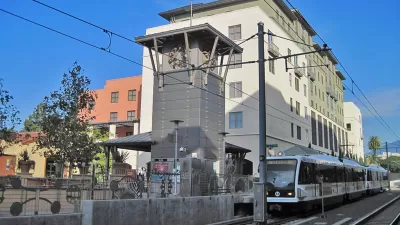From developer incentives to swapping parking for housing units, two transit systems have come up with plans that tackle the region's housing shortage and its economic inequality. What have they agreed to do, and who will hold them accountable?
A few weeks ago, we discussed the catalysts for the adoption of equity and sustainability as core principles in a new development paradigm for the Los Angeles County Metropolitan Transportation Authority (Metro), the Bay Area Rapid Transit (BART), and the Valley Transportation Authority (VTA) in the San Francisco Bay Area. With our recently adopted affordable housing policies, we are taking bold, proactive steps to address both climate and affordability challenges that high-cost regions face in California. LA Metro discussed its plan in the previous post, and here we follow up with BART and VTA.
BART: Affordability is Critical to a Bold Vision
The San Francisco Bay Area’s Sustainable Communities Strategy (SCS), Plan Bay Area (PBA) sets a bold vision to end automobile-dependent sprawl and direct the future population growth (2 million people by 2040) into already existing communities. PBA has been called the most progressive SCS in California because it meets the mandated greenhouse gas (GHG) reduction target by accommodating 100 percent of new growth (1.1 million new jobs and 660,000 new homes) within urban boundaries. PBA directs 95 percent of the region’s growth toward 5 percent of the Bay Area’s land, and two-thirds of the region’s housing production will be accommodated by only 15 Bay Area cities.
The Great Communities Collaborative, or GCC, is a multi-sector collaboration that addresses the challenges of climate change and equity by influencing local and regional policies, practices, and investments. It was founded on the idea that shaping local TOD plans and securing private and public funding to catalyze sustainable and equitable development would transform the region from auto-dependent sprawl to one made up of thriving and affordable neighborhoods linked to economic opportunities by a premier transit network. GCC realized that catalyzing BART’s and VTA’s land for more intensive development with rigorous affordable housing outcomes could significantly help accommodate the region’s growth and meet equity and sustainability goals.
GCC funded BART’s advocacy campaign, spearheaded by TransForm, an advocacy organization that promotes walkable communities with transportation choices to connect people of all incomes to opportunity, and East Bay Housing Organizations (EBHO), a nonprofit organization that aims to preserve, protect, and expand affordable housing opportunities. For over two years, TransForm and EBHO engaged BART board members and agency staff to craft policy parameters and garner support among other advocates. GCC also convened the TOD Implementation Table, a neutral space to engage with transit agency staff, other public agencies, and advocates to further their regional equity and sustainability goals and align philanthropic and public resources. Through GCC’s advocacy efforts, in 2015, BART’s Board of Directors initiated the creation of an Affordable Housing Policy.
In January 2016, the board adopted a policy requiring a minimum of 20 percent of units built on BART-owned property to be affordable. The policy requires each station area to cumulatively achieve a minimum 20 percent requirement, but leaves flexibility as to how the units are achieved so that projects can be phased in a way that makes financial sense. The affordable housing policy also includes direction to BART staff to develop a development solicitation process that favors quantity and depth of affordability, with a preference for housing units serving low- and very-low income households. Affordability is one of many requirements placed on the development of BART property. Other requirements vary by site, but universally include prevailing wage requirements and project stabilization agreements.
In addition to affordable housing policy, BART has worked over the last several months to update its decade-old TOD policy, which offers a more comprehensive policy statement. The new TOD policy, which was adopted on June 9, 2016, addresses three critical updates:
FULL STORY: California Transit Agencies Bring Affordable Housing to Scale

Depopulation Patterns Get Weird
A recent ranking of “declining” cities heavily features some of the most expensive cities in the country — including New York City and a half-dozen in the San Francisco Bay Area.

California Exodus: Population Drops Below 39 Million
Never mind the 40 million that demographers predicted the Golden State would reach by 2018. The state's population dipped below 39 million to 38.965 million last July, according to Census data released in March, the lowest since 2015.

Pennsylvania Mall Conversion Bill Passes House
If passed, the bill would promote the adaptive reuse of defunct commercial buildings.

Google Maps Introduces New Transit, EV Features
It will now be easier to find electric car charging stations and transit options.

Ohio Lawmakers Propose Incentivizing Housing Production
A proposed bill would take a carrot approach to stimulating housing production through a grant program that would reward cities that implement pro-housing policies.

Chicago Awarded $2M Reconnecting Communities Grant
Community advocates say the city’s plan may not do enough to reverse the negative impacts of a major expressway.
City of Costa Mesa
Licking County
Barrett Planning Group LLC
HUD's Office of Policy Development and Research
Mpact Transit + Community
HUD's Office of Policy Development and Research
City of Universal City TX
ULI Northwest Arkansas
Town of Zionsville
Urban Design for Planners 1: Software Tools
This six-course series explores essential urban design concepts using open source software and equips planners with the tools they need to participate fully in the urban design process.
Planning for Universal Design
Learn the tools for implementing Universal Design in planning regulations.


























